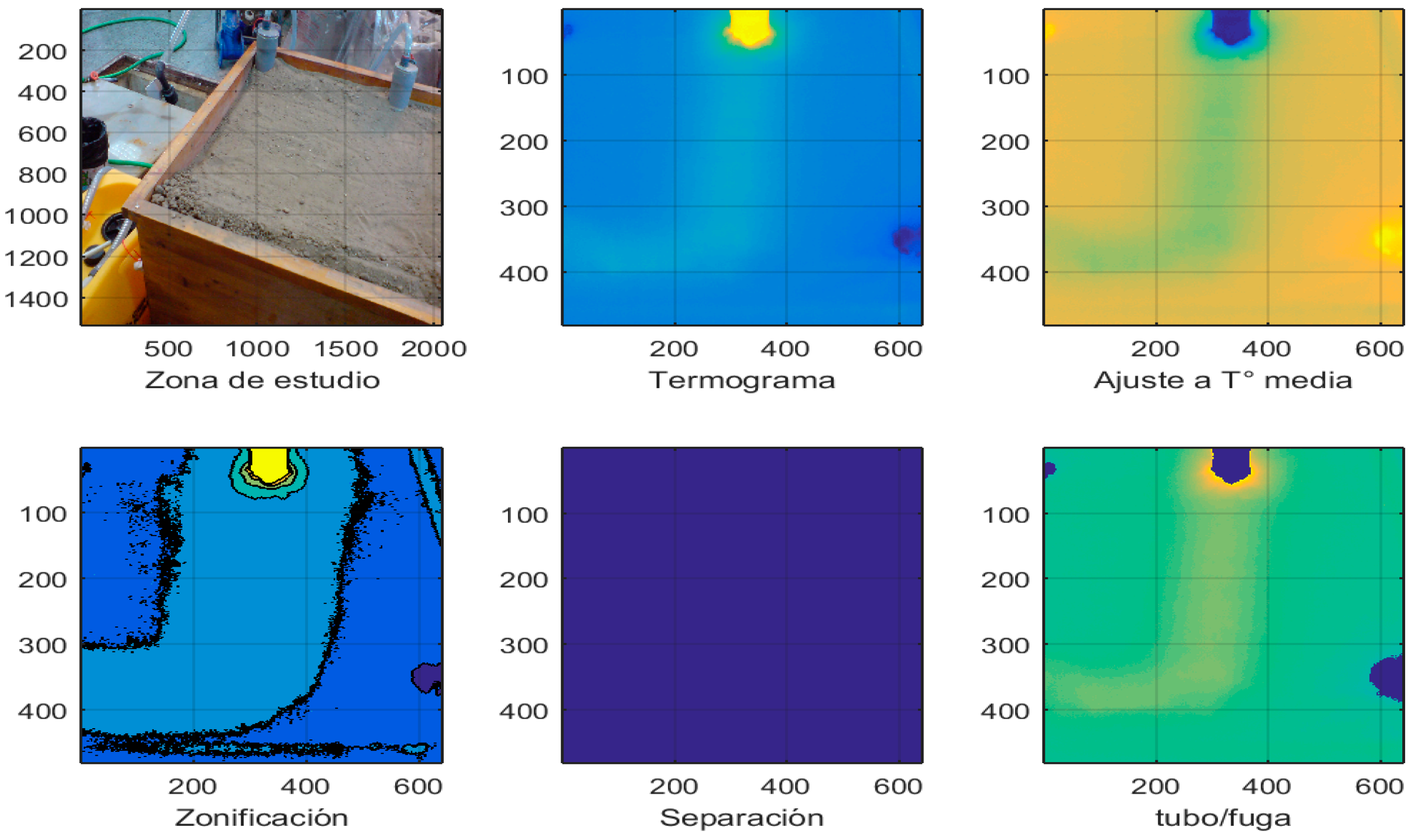Water Leak Detection by Termographic Image Analysis, In Laboratory Tests †
Abstract
:1. Introduction
2. Results Processing Images
3. Discussion
Thermography as a Non-Destructive Test (NDT)
4. Materials and Methods
4.1. Laboratory Model (Case of Study)
4.2. Quality Image Taken and Its Variables for Leak Analysis Detection
4.3. Image Processing
5. Conclusions
Abbreviations
| NDT | Non-Destructive Test |
| WDS | Water Distribution Systems |
| IR | Infrared |
| QIT | Quantitative Infrared Thermography |
| END | Evaluation No Destructive |
| NETD | Noise Equivalent Temperature Difference |
Appendix A. Test ID: Mr-4




Appendix B. Test ID: Mrf-2




References
- Termograf, E.E.N.; Revillas, S.M.; Energ, G.; Ii, N. La Termografía Infrarroja y el deporte de alto rendimiento; Military Institute of Armament Technology: Zielonka, Poland, 2012. [Google Scholar]
- Santulli, C.; La, R. IR Thermography for the Detection of Buried Objects: A Short Review 1. Introduction Studied. A Large Number of Scientific Papers are Available, a List of which, Including Considerations Application-Related Factors, in Particular the State of Environ; Università di Roma: Roma, Italy, 2003. [Google Scholar]
- Shepard, S.M.; Wang, D.; Lhota, J.R.; Ahmed, T.; Rubadeux, B.A. Parallel processing and analysis of thermographic data. Rev. Quant. Nondestr. Eval. 2002, 21, 558–563. [Google Scholar]
- Carreño-Alvarado, E.P.; Ayala-Cabrera, D.; Pérez-García, R.; Izquierdo, J. Identification of buried pipes using thermal images and data mining. In Proceedings of the 16th Conference on Water Distribution System Analysis, Bari, Italy, 14–17 July 2014. [Google Scholar]
- Dudić, S.; Ignjatović, I.; Šešlija, D.; Blagojević, V.; Stojiljković, M. Leakage quantification of compressed air using ultrasound and infrared thermography. Measurement 2012, 45, 1689–1694. [Google Scholar] [CrossRef]
- Mollmann, M.; Vollmer, K. Infrared Thermal Imaging: Fundamentals, Research and Applications; Wiley: Hoboken, NJ, USA, 2014; Volume 1. [Google Scholar]
- Holst, G.C. Common Sense Approach to Thermal Imaging; SPIE Optical Engineering Press: Bellingham, WA, USA, 2000. [Google Scholar]
- Yin, Z.; Collins, R. Augmented Vision Perception in Infrared; Springer: Berlin, Germany, 2009. [Google Scholar]
- Balageas, D.L. Termografía Infrarroja: Una Técnica Multifacética para la Evaluación No Destructiva (END); ONERA (The French Aerospace Lab): Châtillon, France, 2007. [Google Scholar]
- Izquierdo, J.; López, P.A.; Martínez, F.J.; Pérez, R. Fault detection in water supply systems using hybrid (theory and data-driven) modelling. Math. Comput. Model. 2007, 46, 341–350. [Google Scholar] [CrossRef]
- Swiderski, W.; Hlosta, P.; Miszczak, M. IR Thermography methods in detection of buried mines. Proc. SPIE Int. Soc. Opt. Eng. 2012. [Google Scholar] [CrossRef]
- Carreño-Alvarado, E.P.; Ayala-Cabrera, D.; Pérez-García, R.; Izquierdo, J. Identificación de tuberías enterradas mediante termografía. In Proceedings of the XXV Congreso Latinoamericano de Hidráulica, Santiago, Chile, 25–29 August 2014. [Google Scholar]
- UPV Data. Available online: http://dataupv.webs.upv.es/datos-historicos-de-la-observacion-meteorologica-en-valencia/ (accessed on 11 March 2017).
- Atef, A.; Zayed, T.; Hawari, A.; Khader, M.; Moselhi, O. Multi-tier method using infrared photography and GPR to detect and locate water leaks. Autom. Constr. 2016, 61, 162–170. [Google Scholar] [CrossRef]
- Metola, D.R.; Martínez, F.; Valencia, A. Departamento de Ingeniería Hidráulica y Medio Ambiente; Universitat Politècnica de València: Valencia, Spain, 2009. [Google Scholar]
- Astarita, T.; Carlomango, G.M. Infrared Thermography for Thermo-Fluid-Dynamics; Springer: Berlin, Germany, 2015; Volume 1. [Google Scholar]
- Minkina, W.; Dudzik, S. Infrared Thermography, Errors and Uncertainties; Wiley: Hoboken, NJ, USA, 2009. [Google Scholar]
- Živčák, J.; Hudák, R.; Madarász, L.; Rudas, I.J. Methodology, Models and Algorithms in Thermographic Diagnostics; Springer: Berlin, Germany, 2013; Volume 5. [Google Scholar]


| ID | Images Taken | Date (day/month/year) | Study Place | Objective |
|---|---|---|---|---|
| T-1 | 18 | 15/10/2013 | Different places in the UPV | Camera control |
| St-3 | 59 | 01/10/2014 a 17/02/2014 | Site 3 previously chosen | Identify buried structure |
| St-4 | 52 | 10/01/2014 | Site 4 previously chosen | Identify buried structure |
| St-2 | 672 | 18/10/2013 a 17/02/2014 | Site 2 previously chosen | Identify buried structure |
| Exp-1 | 8 | 17/01/2014 | Esplanade UPV | Identify buried structure |
| Mg-1 | 24 | 02/07/2015 | Laboratory model: Gravity pipe | Identify buried structure |
| Mp-1 | 24 | 16/07/2015 | Laboratory model: Buried thermic objects | Determinate the buried colocation distance |
| Mgf-1 | 98 | 07/10/2015 | Laboratory model: Gravity pipe with leak | Identify buried structure and leak |
| Mgf-2 | 10 | 08/10/2015 | Laboratory model: Gravity pipe day after | Identify buried structure and leak |
| Mr-1 | 51 | 13/06/2016 | Laboratory model: Recirculating pipe, cover surface | Variable study |
| Mr-2 | 39 | 30/06/2016 | Laboratory model: Recirculating pipe | Visualize behavior |
| Mr-3 | 83 | 03/08/2016 | Laboratory model: Recirculating pipe, thermic contrast | Variable study |
| Mr-4 | 25 | 04/08/2016 | Laboratory model: Recirculating pipe | Visualize behavior |
| Mr-4 | 60 | 16/08/2016 | Laboratory model: Recirculating pipe, thermic contrast | Visualize behavior |
| Mrf-1 | 15 | 23/09/2016 | Laboratory model: Recirculating pipe with leak | Identify buried structure and leak |
| Mrf-2 | 15 | 10/09/2016 | Laboratory model: Recirculating pipe with leak | Identify buried structure and leak |
Publisher’s Note: MDPI stays neutral with regard to jurisdictional claims in published maps and institutional affiliations. |
© 2019 by the authors. Licensee MDPI, Basel, Switzerland. This article is an open access article distributed under the terms and conditions of the Creative Commons Attribution (CC BY) license (https://creativecommons.org/licenses/by/4.0/).
Share and Cite
Pauline, E.; Carreño-Alvarado; Meza, G.R. Water Leak Detection by Termographic Image Analysis, In Laboratory Tests. Proceedings 2020, 48, 15. https://doi.org/10.3390/ECWS-4-06440
Pauline E, Carreño-Alvarado, Meza GR. Water Leak Detection by Termographic Image Analysis, In Laboratory Tests. Proceedings. 2020; 48(1):15. https://doi.org/10.3390/ECWS-4-06440
Chicago/Turabian StylePauline, Elizabeth, Carreño-Alvarado, and Gilberto Reynoso Meza. 2020. "Water Leak Detection by Termographic Image Analysis, In Laboratory Tests" Proceedings 48, no. 1: 15. https://doi.org/10.3390/ECWS-4-06440
APA StylePauline, E., Carreño-Alvarado, & Meza, G. R. (2020). Water Leak Detection by Termographic Image Analysis, In Laboratory Tests. Proceedings, 48(1), 15. https://doi.org/10.3390/ECWS-4-06440





